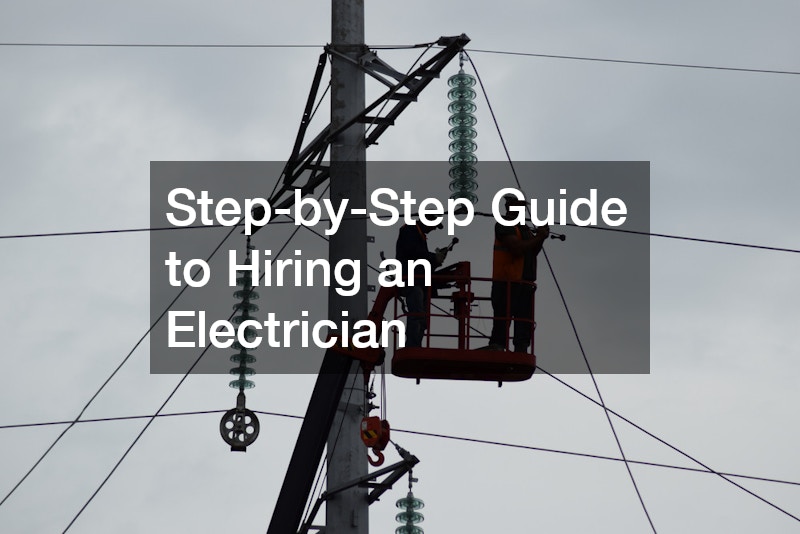Hiring an electrician is one of the most important decisions a homeowner or property manager can make when it comes to maintaining safety and function in a building. From minor repairs to major installations, ensuring you have the right professional on the job can save time, money and stress.
Whether you’re planning renovations, addressing a fault or simply upgrading old fittings, following a clear process helps you choose the right person for the task.
In Australia, all electrical work must be carried out by a licensed and qualified electrician. This is not just a matter of quality—it’s a matter of legal and personal safety. Improper installations or faulty wiring can lead to fires, injury or costly damages. Here’s a straightforward guide to help you find the right electrician for your needs.
Step 1: Understand Your Needs
Before you begin your search, take time to clearly identify the type of work you require. Are you installing new lighting or power points? Do you need a complete rewire of an older home? Are you adding an outdoor entertainment area that needs proper electrical setup? Knowing what you need will help you communicate clearly with potential electricians and allow them to provide accurate quotes and timelines.
If you’re unsure about the specifics, don’t worry. A qualified electrician can assess your space and help determine the best course of action. Still, having a general idea of the job will give you a head start and avoid unnecessary confusion during the process.
Step 2: Verify Licensing and Insurance
In Australia, any electrician you hire must hold a valid licence to perform electrical work legally. This ensures they have completed the required training and follow strict safety standards. Always ask to see the licence number, and verify it with the relevant authority in your state or territory if you have any doubts.
Equally important is public liability insurance. This protects you and the electrician in the event of accidental damage or injury during the job. A professional will have no issue providing proof of insurance, and you should never proceed without it.
Step 3: Ask for Recommendations and Do Your Research
Word of mouth remains one of the best ways to find a reliable electrician. Ask friends, family or neighbours if they’ve had a positive experience with someone recently. Real estate agents, local building contractors or property managers can also offer referrals based on your location.
Once you have a shortlist, look up each electrician online. Read reviews on independent sites or community forums and check for a strong presence and consistent feedback. While no professional can please every customer, patterns of satisfied clients and resolved issues are good signs of a trustworthy business.
Step 4: Request Detailed Quotes
Contact at least two or three electricians and ask them to inspect the job in person before giving you a quote. Avoid accepting vague pricing over the phone unless it’s a standard service with a fixed rate. A quality tradesperson will be happy to visit the site, assess the work and provide a clear, itemised quote that includes labour, materials and timeframes.
Don’t automatically go with the cheapest option. Instead, focus on value and professionalism. A slightly higher price from someone experienced and communicative may save you from unexpected problems or hidden costs later. Ask what the quote includes, how they handle variations and whether they offer warranties on their work.
Step 5: Discuss Timelines and Communication
Before hiring, ask about the expected start and finish dates. Reliable electricians are often in demand, so you may need to be flexible with timing. However, someone who values your time will be upfront about availability and aim to fit you in as soon as possible.
Good communication is key to a successful job. Your electrician should respond promptly to calls or emails, explain things in plain language and show genuine interest in doing the job right. These early signs of professionalism often reflect the quality of their work on site.
Step 6: Review the Contract and Agree on Terms
Once you’re happy with the quote, request the agreement in writing. This doesn’t have to be overly formal, but it should clearly outline the scope of work, costs, timelines and warranty terms. Review it carefully and ask questions if anything is unclear.
Having the details in writing protects both parties and provides a reference point if any concerns arise during the project. It also shows the electrician is committed to a transparent and professional relationship.
Step 7: Inspect the Completed Work
When the job is finished, take time to inspect the work. A good electrician will walk you through what’s been done, test everything for safety and function, and leave the area clean and tidy. If the job involved a compliance certificate or inspection, ensure this is completed and any paperwork is provided to you.
If you’re satisfied with the service, keep their contact details for future use and consider leaving a review. Supporting reliable local trades helps others in your community find trustworthy professionals.
Hiring an electrician doesn’t have to be stressful. By taking a step-by-step approach—understanding your needs, checking credentials, comparing quotes and maintaining open communication—you can find the right person for the job. Investing in a qualified electrician ensures the safety, efficiency and reliability of your electrical systems, both now and into the future.

